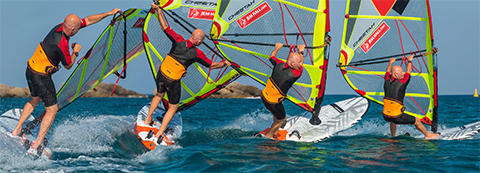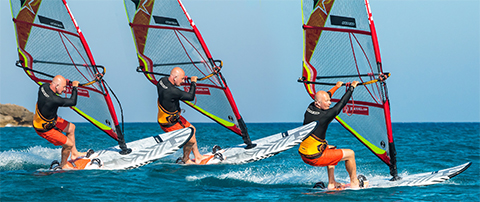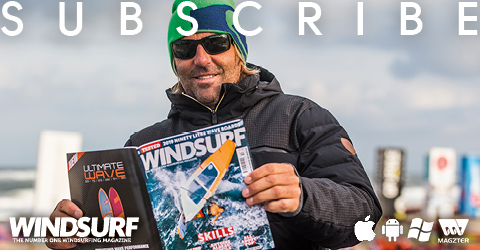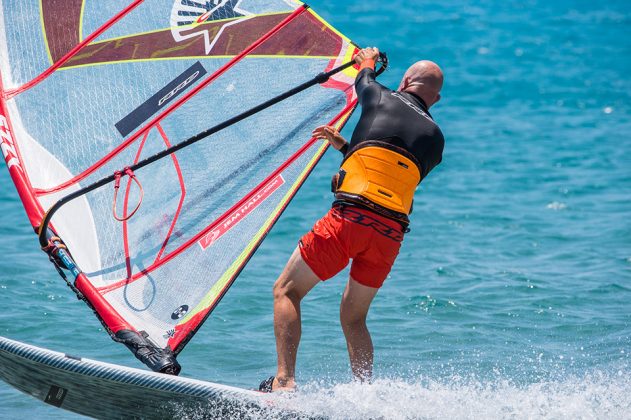JEM HALL
MOVE ON UP – WINDSURFING TECHNIQUE
THE DUCK GYBE
This month I urge you to get into and improve the duck gybe as it feels great, looks cool and is another fantastic milestone in our sport. It is also simpler, in some ways, than the carve gybe and will actually help you improve these too. It may actually yield your first planing exit in a gybe!
Words Jem Hall // Photos Nicolas Jones
www.jemhall.com
(This feature originally appeared in the November December 2018 issue of Windsurf Magazine. To read more features like this first, Print and Digital subscriptions are available. Prices include delivery globally for 10 x issues a year!)
Learning
If you are making a good amount of carve gybes, between 30-50%, and have the ability to scissor the board downwind and get the sail light under control, then you are so ready to try some duck gybes. A lot of the component parts can be learnt in light winds, just as for the carve gybe.
It is best to do the moves I suggest on a big board, like a higher volume freemove board, or a beginner board and even better on a windSUP as they track better and give you more time to steer.
Here are some drills to work on:
• Clew first (CF) beach start into a gybe: The CF beach start is a great skill builder for both your waterstarts and gybes so get it in your armoury. After completing your CF beach start, sail out off the wind and steer downwind, through rig and feet, and then as you get to the run (dead downwind) start to look to the new direction and change your feet as you subtly sheet the sail in. It will feel more natural than you think and you will begin to anticipate the point at which the foot change feels right.
• Sailing switch: Sail along a touch off the wind and pull down on your front hand as you open the sail slightly. Now twist your front foot back to be in front of your back foot and then step forward with your old back foot and hey presto you will now be sailing switch. Focus on front foot pressure, with your hips out and lots of ‘down’ force on the front foot. Then switch back and do it a few more times, and, of course, in both directions.
• Sail ducking: Now you can get the sail rotation part of the move nailed. Sail along, slightly off the wind, with a wide stable stance. Slide your back hand down the boom. Tip the rig towards the nose of the board. Let go with your front hand. Lean back as the rig gets heavy here. Cross front hand over to reach to the VERY back of boom. Whip the sail across past your ear and be aggressive. Catch sail on the new side with front hand past the front harness line. Hold it clew first and then rotate the rig. Look forwards throughout. Do it many times and both ways!
• The big cookie: You are now ready to put all this together, i.e. sail along, duck the rig, steer and then do the foot change and with your switch sailing skills you have the option to mix it up and either do your foot change late or early. Having this option is great for the planing version, as I will highlight later.

Here is a duck gybe sequence on a 6.5 and a FreeMove 110 with a 35cm change down fin, about the biggest kit you can learn and improve on.
Main tips
Now let’s get down to business on the planing version. Rather than going through this in a didactic manner I have found throughout my coaching that it is best to enthuse people to try the move and equip them with a few simple tips and then coach them through it. Think of it as this sequence of events:
1. Prepare as per a carve gybe.
2. When the sail is light duck the rig and collect it.
3. Finish the carve and do your foot change when it feels right and believe me you will notice this quite naturally.

This is the strap to strap ending for when you have more speed, like here on a 5.8.
Focus on these key tips:
• Tipping the rig forward: The action of tipping the rig with the back hand towards the nose will help with the carve but more importantly it will stop the dreaded mast hitting the water crash.
• Get old front hand to back of boom: This is crucial and very much a deal sealer. With your hand right at the back you have more leverage to pull the sail across and this will help with a smoother carve.
• Duck, pull and look – this is your mantra, so say it and believe it. You duck by bending your knees and ankles; you then pull the rig across you hard as you look to your exit.
• Catching the sail open and keeping low: If you get your new front hand to past the front harness line, and your back hand is patient enough to land near it, then your sail can breathe and assist you to power through the rest of the move. And if you are ‘getting down James Brown’ then your carve and foot change will be smooth.
• Rig moves to outside, hips move to inside: This happens after collecting the rig and places you in a strong counter balance to carve board out.
• Pull down on front hand and get a slick foot change: Pulling down on your front hand will lighten your feet so you can switch them and get your new back foot into a strong position on the rail to complete the carve.
TIPS TO BOOST YOUR DUCK GYBES
From what I have experienced in my own ducks, and what I have gleaned from coaching, these are some of my best tips:
• Go (duck) early; duck the rig as soon as the sail is light.
• The sail can actually get too light if you do too long a broad reach preparation, and is then more likely to ‘hinge’ and go mast first into the water.
• Tip and let go for big sails. Larger sails have longer booms, so in order to get your old front hand to the back of the boom you have to somewhat fling the rig forward and let the tail piece become available to you.
• Again, get your hand to the very back of the boom. This gives you leverage and a good base to grab and pull from!
• Really pull the sail across you. It is akin to wiping sweat from your brow with your forearm. Be aggressive and direct.
• Keep carving and look out of the turn. A great mantra here is ‘drop (body / knees) and extend (arms)’.
• Try to stroke your free hand in the water: This will make you get low and really pull the sail across you and feels great.
• Feel the power for your foot change. If you are well powered and on ‘carvier’ boards then a later foot change is good. Bigger boards, and less power suit an early foot switch so you can carve out, tightening your arc with your heels.
• Don’t limit yourself, duck onto and off a wave, duck bigger sails, do the move both overpowered and underpowered, try a hand drag duck gybe à la Robby Naish.
Conditions for learning:
Flat water or between waves so you can keep speed.
Medium wind so your sail is not too big and goes weightless easily.
FAULT ANALYSIS
Let’s look at the some of the common faults and how to fix them.
• Mast hits the water as hands cross over and you get launched. This is due to the sail hinging off your back hand and you not tipping the rig forward, so please tip it forward!
• Rig rips out of your hands as you collect it. You have ducked the rig too late, so duck it earlier.
• Board stops turning after the duck and straightens up. You are likely gear gazing, which will centralise your hips and stop the carving continuing. Remember to look at your exit to keep the board carving and be low.
• Catapult at end of the move. You sense the end is in sight and get excited, so you sheet in (power up) too early, i.e. too far off the wind on the new side. Finish the mission by staying low with the sail open until you are more across the wind.
• Stalling the sail mid carve. This is due to over sheeting in the middle of the carve whilst still downwind. It is exacerbated by not getting your hands far enough down the boom on the new side.
Kit for learning:
‘Turnier’ boards like Freemoves or Freestyle-Waves and with a fin that is not too big, 35cm and under.
The sail should be 6.0 or under, but bigger riders can go up to 6.5. 7.0 is a challenge for me.
Bigger straps enable carving and smooth foot changes.
RRD boards, wetsuits & softwear, Ezzy Sails & Black Project fins sponsor Jem Hall. Get him live and direct on one of his highly acclaimed coaching holidays but be quick as they are selling out – check out his fab new site www.jemhall.com for details. You can also follow him on twitter / Facebook / Instagram.
www.jemhall.com






